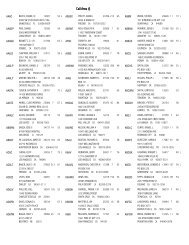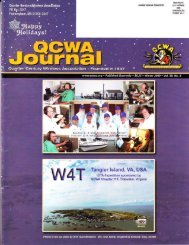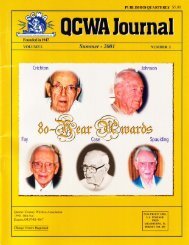ASHLAND, MA PEBMIT NO.7 - Quarter Century Wireless Association
ASHLAND, MA PEBMIT NO.7 - Quarter Century Wireless Association
ASHLAND, MA PEBMIT NO.7 - Quarter Century Wireless Association
Create successful ePaper yourself
Turn your PDF publications into a flip-book with our unique Google optimized e-Paper software.
The Retirement Years<br />
(continued from the winter 2008 lssue of the QCWA lournal)<br />
A Journalistic History of The Life and Times in Amateur Radio of George Hart, Wl NJM<br />
by George Hart, WI NJM<br />
I have already covered much of this in previous pages, but the<br />
end of an era in my amateur radio career occurred with the<br />
passing of my brothet Ed Hart, N4KB, formerly 3NF, W3NF.<br />
W9NF, W2ZVW K2FB, W5RE. Ed had been a chain smoker<br />
since age 17. His brand was exclusively unfiltered Camels, and<br />
he consumed as many as three packs a day. ln our more than<br />
sixty years of a close sibling association I have never known<br />
him to be seriously ill, but in his 76th year his health started to<br />
deteriorate and on January gth, I988, a combination of cancer<br />
and encephalitis ended his life after an illness of several<br />
months during which no hope existed. What an amazing constitution<br />
he must have had to endure all that nicotine poisoning<br />
for so many years! lf he'd had the will power and incentive<br />
to quit smoking at an earlier age he might still (in 200'l) be<br />
alive.<br />
I have always said that Ed was a much more "compleat" amateur<br />
radio operator than I have ever been. He was first<br />
licensed in 1925 after several years of tinkering with radio,<br />
held the highest class of amateur license available all the rest<br />
of his life, was continuously active on the air during all that<br />
period except for the 1941-1945 war years. He was not only a<br />
highly proficient CW operator, through long experience he had<br />
also accumulated a great deal of technical knowledge. At one<br />
trme he held a second class commercial radiotelegraph license<br />
but never upgraded this because he never operated commercially.<br />
Wherever he lived, he achieved a high level of prominence<br />
among amateur radio circles.<br />
Ed and l, despite being brothers. were never much alike. Being<br />
the namesake of his famous father much was expected of<br />
him, more than he was able to achieve, resulting in an inferiority<br />
complex which was often mistaken for the exact opposite.<br />
He failed at Lafayette, not so much because of lack of<br />
ability as of his refusal to be an image of his father; but in my<br />
opinion he was a better electronics engineer than many a college<br />
graduate in that field - largely through his experience<br />
with and enthusiasm for amateur radio. During our adolescence<br />
and early maturity he was my mentor and my " Elmer, "<br />
but never my ideal. ln all technical phases of amateur radio I<br />
acceded to his superiority, but in CW operating proficiency,<br />
except in the early stages, lconsidered myself his equal. Not<br />
until I joined the ARRL headquarters staff and achieved a modicum<br />
of prominence therein did I feel he held me in any kind<br />
of respect, even grudging.<br />
While we had several such sibling rivalries. during our later<br />
years we became ever closer. ln the latter stages of his illness I<br />
spent many hours at his bedside as we relived our lives together.<br />
ln all that looking back at happier, more fruitful days, I<br />
think Ihelped hrm achieve a higher sense of acceptance and<br />
relaxation, lran a keying line from his backyard 'shack" to his<br />
bedside and installed both a HF receiver and 2-meter transceiver<br />
there so he could maintain contact with his many amateur<br />
radio frrends. The latter. when he was not using it elsewhere,<br />
remained tuned to 146.49 MHz simplex, our "intercom" frequency.<br />
On January 9, 1988, the voice of Bonny Somers, who<br />
was helping take care of him, came over this "intercom" with<br />
the message, "George, you better get over herel" Ed was<br />
gone.<br />
Pauline, Ed s wife, turned over to me every vestige of Ed's<br />
amateur radio inventory. His son Paul, who was employed as<br />
an executive for an association of independent telephone<br />
companies, came down from Washington to help his mother<br />
handle all other matters. There wasn't a great deal of money<br />
involved in Ed's lifetime accumulation of amateur radio gear.<br />
Much of it was obsolete, still serviceable but having little market<br />
value. I decided to acquire a few items of usable gear and<br />
conduct an auction for the rest, turning the auction proceeds<br />
over to Pauline. The activity turned out to be more of a tag<br />
sale than an auction. The local radio club turned out for it,<br />
helped Paul and me take down some of the antennas, buying<br />
some of them and some of the other remaining gear. Most of<br />
the transmitting equipment in his shack I decided to just leave<br />
there, with Pauline's permission, until I could dispose of it,<br />
including the vast amount of unsold items. mostly "junk" to<br />
be disposed of later.<br />
I had ideas of setting up the big Barker & Williamson PP813<br />
amplifier in our Coachmen trailer and using it to send my high<br />
speed code practice and to participate in NTS, but measurements<br />
disclosed that it was too bulky. Then Pauline said I could<br />
continue to use the backyard shack any way I wished, so I put<br />
up a couple of dipole antennas in the tall pine trees and came<br />
over from Citrus Park on Sunday and Wednesday nights to<br />
send the HSCP.<br />
It was a good arrangement, allowing me to continue the HSCP<br />
program as Wl NJM/4 with the same commanding signal that<br />
had been achieved with N4KB, using the same equipment. My<br />
NTS-TCC schedules, other NTS and local 2-meter activity were<br />
all conducted from my trailer at Citrus Park, some 7 miles<br />
away. The weekly TCC schedule was with Cecil,W6EOT. With<br />
my 100 watts and 2O{oot-high dipole the contact was sometimes<br />
tenuous, but thanks to Cecil's superior operating abtlity<br />
and better antenna we usually managed it. When it came time<br />
for us (Louise and me) to return to Connecticut I would take<br />
down the antennas and store them in the shack. Returning for<br />
the next winter stay, I would re-erect the antennas. Despite<br />
the hot, humid Florida summers, none of the equipment left in<br />
Ed's shack broke down. When we returned in the fall, it<br />
46 QCWA Journal r Summer 2OO9 r w\\\^i,qcwa.org


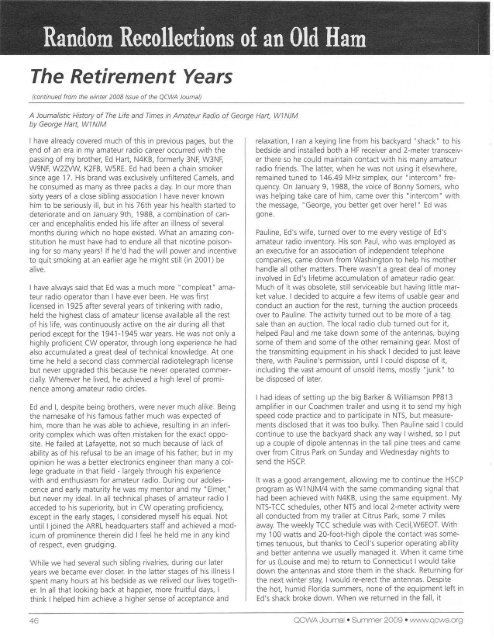
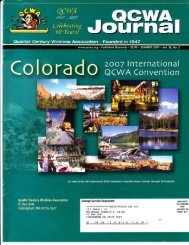
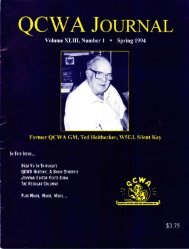
![11{J hI EfifSIt]E I]E - Quarter Century Wireless Association](https://img.yumpu.com/11816560/1/190x245/11j-hi-efifsite-ie-quarter-century-wireless-association.jpg?quality=85)
